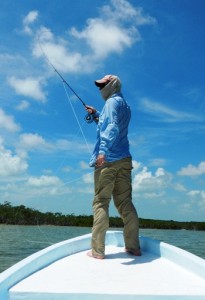
Casting… work on it.
Casterbating – v – casting a fly line repetitively without shooting the line or adding much/any distance to the cast.
You see the fish, on your own, or with a guide, and you start casting… and you keep casting… you need a little more distance and you are letting out a foot at a time… the line is in the air and things start coming a little undone as the amount of line gets longer and longer… and then it all falls apart. You dump a bunch of unorganized line on the water. You can almost hear the fish scream as they run away. If you are fishing with a guide, you can definitely hear the guide screaming.
Many threats to bonefish come from above. So, in addition to just not really adding much to the actual cast, casterbating runs a good chance of just spooking the fish due to the arial movement.
Maybe you’ve fished with that guy. Maybe you are that guy. Condolences either way. We’ve all been there.
Casterbating is a saltwater sin, punished by the fishing gods with no delay.
How do you know if you are casterbating? Did you do more than three false casts? Yes? Then you are casterbating.
Maybe some day they’ll come up with a patch or some gum to help break you of this habit, but in the meantime, there are a few tips I have to keep you from casterbating, at least in public, in front of the fish.
- Starting point – How much line do you have out to begin with? If you don’t have enough line out, you wont’ be able to load the rod. It is pretty hard to load the rod with 5 feet of fly line out. You’ll usually need 15′-20′ feet of line out the tip of your fly rod in order for there to be enough fly line to properly load the rod on your first false cast.
- 3 and let fly – By the time you get to your third false cast, you should be shooting your line. Past that number and you hit the point of diminishing returns. It is harder to manage line in the air. The more line you have in the air, in your cast, the harder it is to maintain and control. If you have a good loop going and are properly loading the rod, by the time you get to your third cast you have everything you need to shoot the line.
- Don’t let go of the line. It may seem like a good idea to let go of the line with your line-hand when you shoot the line. That is not correct. Keep the line in your hand as you are shooting the line. If you keep the line in your hand you’ll be ready for action when the fly hits the water, instead of grasping (and missing) the line and trying to get everything under control. There are those times when a fish eats AS SOON AS THE FLY lands. Bonefish do this sometimes, as do tarpon. If you have the line in your hand, you are ready for business. This last tip isn’t really a casterbating tip, but it’s a pretty good one anyway.
If you can get away with two false casts, that’s better than three. Four casts is one too many and five is straight out.
You don’t need all those extra casts. They just put a greater chance for user error into the whole enterprise. They may spook the fish. You are unlikely to get a better cast on your 8th false cast than on your third. If you are casting, your fly is not in the water and you are not fishing. So… knock it off with the casterbating.
Tags: casting, fly fishing


Holy Grail! Haha
Best. Movie. Ever.
I totally thought this was going in another direction. In my mind casterbation (n.) is when an angler just can’t stop casting as we’re moving along, looking for fish. You know, the one that just makes a few false casts to practice and warm up, but keeps doing it all day. It’s also known as blind casting, which on a bonefish flat is also a sin. 😉
Blind casting for bones is a sin… unless it works.
See, I think of casterbation as the guy who keeps casting and casting when the guide is saying “lay it down. drop the cast. stop casting!”